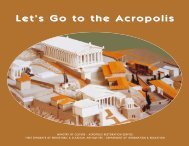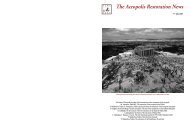τεύχος περιλήψεων - ΥΣΜΑ
τεύχος περιλήψεων - ΥΣΜΑ
τεύχος περιλήψεων - ΥΣΜΑ
Create successful ePaper yourself
Turn your PDF publications into a flip-book with our unique Google optimized e-Paper software.
6TH INTERNATIONAL MEETING FOR THE RESTORATION OF THE ACROPOLIS MONUMENTS - ABSTRACTS 37<br />
THE ARCHAIC ACROPOLIS BASED ON THE POROS ARCHITECTURAL MEMBERS<br />
PROPOSALS FOR THE DISPLAY OF THE MATERIAL<br />
E.P. Sioumpara, Archaeologist, Ph.D. Head of the Inventorying, Documenting and Organizing<br />
the Scattered Architectural Members Office, YSMA<br />
The focus of this paper is on the presentation of the new findings of the research that has been<br />
carried out in the context of recording, arrangement, and full documentation of the poros architectural<br />
members of the Acropolis, especially of the members originating from the archaic<br />
buildings of the 6th century BC. Particular emphasis is given on the so-called “Hekatompedon”<br />
temple, the first Athenian monumental, Doric peripteral temple made of stone, which was built<br />
around 570 BC. New identifications of architectural members as well as recent observations on<br />
members that are already known, along with newly-identified adjoining fragments of architectural<br />
members, have been recorded and fully documented through drawings. These constitute the<br />
basis for new approaches to issues pertaining to the morphology of the “Hekatompedon”temple<br />
and to topographical questions regarding the archaic Acropolis.<br />
Upon immediate completion of the programme for the poros architectural members of the<br />
Acropolis, which includes the last joinings of the largest in size poros architectural members, two<br />
key issues arise: (i) first and foremost, the question of the systematic organization, classification<br />
and storage in a closed space of all the scattered material including the poros architectural members,<br />
which are in danger of losing the information they bear due to the frailty of their material,<br />
and (ii) secondly, the question of displaying all this material in order to advance – both to experts<br />
and to the general public – the unique, poros architecture of Athens in the 6th century BC. The proposed<br />
display may be realized both in a closed space and, under appropriate conditions, in an<br />
open space.<br />
In conclusion, the aforementioned issues are open for discussion, as are proposals for systematizing<br />
the model for managing and displaying a large number of heterogeneous scattered material<br />
at an archaeological site of the extent and visitability of the Acropolis. Further goal is the<br />
extension of the application of the methodology for the management of the scattered material<br />
(“membra disjecta”) to other archaeological sites with similar characteristics.








